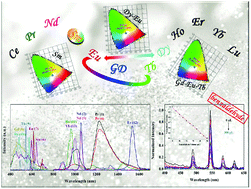Luminescence and white-light emitting luminescent sensor of tetrafluoroterephthalate-lanthanide metal–organic frameworks†
Abstract
Two types of sixteen complexes 1–16, namely, {[Ln(TFBDC)1.5(H2O)]·2H2O}n [Ln = Pr (1) and Nd (2)] and {[Ln(TFBDC)1.5(H2O)2]·H2O}n [Ln = Ce (3), Pr (4), Nd (5), Sm (6), Eu (7), Gd (8), Tb (9), Dy (10), Ho (11), Er (12), Yb (13) and Lu (14)], {[Dy0.281Eu0.719(TFBDC)1.5(H2O)2]·H2O}n (15) and {[Gd0.871Eu0.103Tb0.026(TFBDC)1.5(H2O)2]·H2O}n (16), were isolated by the reaction of LnCl3·6H2O with 2,3,5,6-tetrafluoroterephthalic acid (H2TFBDC). X-ray crystallographic analysis revealed that 1 and 2 exhibit 3D network structures and complexes 3–14 feature 2D network structures formed via three different coordination modes of the ligand. Luminescence spectra revealed that these complexes exhibit broad-spectrum luminescence from the visible to the near-infrared (NIR) region. Unexpectedly, complex 1 exhibits a unique NIR luminescence pattern and the longest lifetime among reported molecular praseodymium complexes. White-light emission was realized via three approaches using the single-component complex 6 (Sm), the two-component complex 15 (Eu and Dy) and the three-component complex 16 (Eu, Tb and Gd). Complex 9 exhibits high sensitivity and selectivity in its luminescence response to benzaldehyde, which provides a promising luminescent sensor for the detection of benzaldehyde.



 Please wait while we load your content...
Please wait while we load your content...